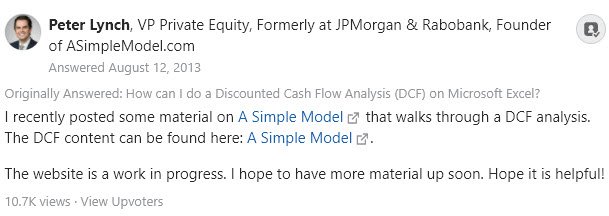I’m a huge fan of Peter Lynch. No, not the mutual fund manager, the other one – the private equity guy who thinks he’s a nerd, but he’s not. He also created the Excel-based A Simple Model which is growing by leaps and bounds. We also talk about private equity and acquisitions. He’s our guest on the CFO Bookshelf podcast.
Notes on Peter’s Origin Story
- Many kids collect, study, and memorize stats on the backs of baseball cards. Peter started reading his dad’s Seth Klarman letters at an early age (granted, he didn’t always understand what they meant).
- Started his career at JPMorgan in South America.
- Learned financial modeling through great advice from two of his managing directors in an early position.
- When starting out financial modeling, start every project from scratch.
When Might a PE Fund’s Success Slip?
I had never thought about this before, but Peter mentions that a private equity fund might be experiencing success in a certain niche. Then there is the temptation to raise money for a new fund thinking that success might be replicated. Peter’s perspective on this concept was fascinating.
The Best Way to Learn Financial Modeling
- Peter did not like the first boot camp he attended on financial modeling.
- He then created his own modeling manual using the three-statement approach where the P&L, Balance Sheet, and Cash Flows are connected.
- University professors tend to be abstract when teaching financial modeling – they thing employers should then teach the practical aspects of modeling.
- You need a teacher or mentor who can provide tacit knowledge (Mark’s very strong opinion – Peter Lynch and A Simple Model are extremely pragmatic but still provide the academics in their teaching approach).
Peter Started Gaining Traction with A Simple Model on Quora
In the beginning, Peter told us he liked keeping a low profile by not attaching his name to the product or website. A member in his audience challenged him about this suggesting viewers want to know the name and face behind financial modeling content.
Quora turned out to be a strong platform for sharing his message. On the show, he mentioned an answer he shared on Quora in creating a DCF model in Excel back in 2013 which has nearly 11k impressions.

You can follow Peter Lynch on Quora here.
What is A Simple Model?
- Started as a hobby
- Started scaling in website impressions
- Added a small monthly subscription
- New updates added about quarterly
- Strong educational content
- The audience now includes professors at universities and even those in recruiting
- In short, videos are shown how to run and apply the three-statement model

A Key Customer for Financial Models
During the conversation, we talked about who benefits greatly from a financial model. It’s not just the finance team, the Board of Directors, investors, or bankers. There’s someone else who benefits.
Peter’s Favorite Model Used During an Acquisition
- The deal was not closed
- All purchase orders of the target company were run through a DOS-based application
- The owner was making all his money through just three products – the rest were not profitable
Peter addresses another deal where it could not have come together without the modeling.
The False-Positives of Financial Modeling
- All the financial metrics pointed in the right direction
- Be careful in putting too much weight in a financial model – models are tools, not the territory
- You still have to ask hundreds and hundreds of questions during due diligence
- Financial modeling is more than spending hundreds of hours behind a PC – the human element and interaction with others cannot be stressed enough
Books Peter Lynch Likes
Below are two books Peter likes to gift to others.


Peter Lynch – What is Your TEDx Talk?
We ask every guest what their TEDx talk would be. Peter had two ideas, but we’re not going to spoil the answer.

Leave a Reply